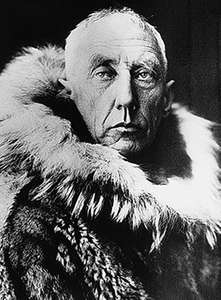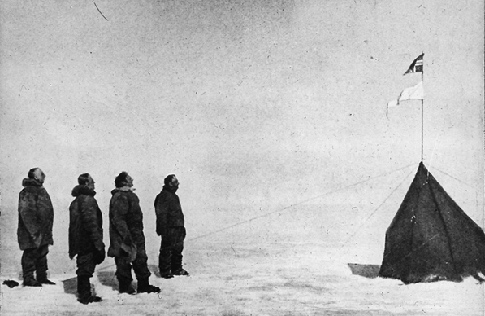
First man to the South Pole – Antarctica
Roald Amundsen had achieved a great deal in polar exploration before he ever set his sights on reaching the South Pole.
He was born in 1872, in the town of Borge, near Oslo, Norway and although he started studying medicine he left it and went to sea where he joined the Belgica, the ship that carried the Belgian expedition that was the first to overwinter in Antarctic ice in 1897.
A few years later, in 1903, he would lead a 6 man crew in the sloop Gjoa in an attempt to sail through the Northwest Passage in the Arctic and completed his mission in 1905. It was on this trip that he learned much about polar survival from the Netsilik Inuit people and learned to use sled dogs for transportation. He returned to Norway a hero.
His next expedition was planned to allow his ship to be trapped in sea ice and drift with the ice across the North Pole making him the first to do so. His plans were derailed when Robert E. Peary announced in 1909 that he had reached the North Pole. Pretending to continue his plans to drift to the North Pole, Amundsen instead decided to make an attempt on the South Pole. Amundsen hid this information from his crew and only his brother knew his true objective
This lie would give him a reputation of unsportsmanlike behaviour, especially amongst the British, and debate about it continues today.
He left Norway in 1910 in Fritjof Nansen’s ship, the Fram (meaning ‘forward’) and after reaching the Madeira Islands, off the northwest coast of Africa he sailed south to the Bay of Whales in Antarctica. He chose this site partly because it gave relatively easy access to Antarctica and was 100km (60 miles) closer to the pole than Robert Falcon Scott’s base at Cape Evans. Scott was in Antarctica at the same time as Amundsen and they both had the same goal of reaching the pole.
Amundsen made the unusual choice of basing himself on the ice shelf, whereas most expeditions looked for solid land. It was risky because ice shelves can break apart and in fact, the Bay of Whales gradually narrowed, and then in the early 1950s the bay was nearly destroyed when advancing ice sheets collided and broke off, carrying away part of Admiral Byrd’s Little America IV station. In 1987 the bay disappeared completely when a 159km (99 mile) iceberg also broke away.
Unlike Scott and Shackleton, Amundsen had great faith in dogs to carry him to the pole. Although Scott had a reputation for good organisation Amundsen was arguably much better and didn’t leave anything to chance.
Amundsen set out with 4 companions, 52 dogs, and 4 sledges on October 19, 1911, and luckily encountered good weather for most of the trip. His party only found a few obstacles and the dogs performed admirably taking them to the Pole and arrived on December 14, 1911. Amundsen noted in his diary: “We had a celebration dinner: a small piece of seal meat each.” They recorded scientific data and left a tent and a message for Scott before returning to their base on January 25th, 1912 with 11 remaining dogs.

He and his team returned to Hobart, Australia in 1912 where he let the world know of his success. Compared to Scott, Amundsen’s journey to the pole was relatively smooth and uneventful.
Scott’s party would reach the pole on January 17th, 1912, only to find Amundsen’s tent and message. Disheartened, the party set out on their return journey but encountered bad weather. Unlike Amundsen, Scott’s party had no dogs at this point and were man-hauling the sledges. They ran out of food and fuel and all perished.
Amundsen again returned a hero to Norway and set up a successful shipping business. His next adventure was to try and reach the North Pole by airplane and in 1925, with the American explorer Lincoln Ellsworth, he reached within 250km (150 miles) of the North Pole.
In 1926, he passed over the North Pole in an airship with Ellsworth and the Italian aeronautical engineer Umberto Nobile. In 1928, this same man, Nobile crashed his airship, Italia, near Spitsbergen and Amundsen set out by aircraft to rescue him but disappeared. It is believed that he crashed into the Barents Sea in fog.
Amundsen’s books include The South Pole (1912) which is a good read and, with Ellsworth, First Crossing of the Polar Sea (1927). Amundsen-Scott Base is named after him as well as a number of other sites in the Arctic and Antarctic. He was a brave man and one of the leading lights of polar exploration.

